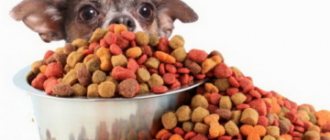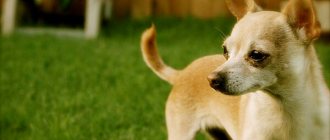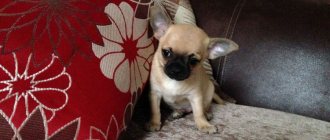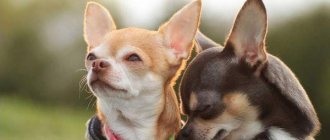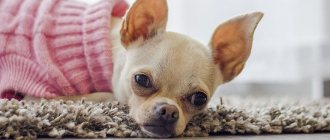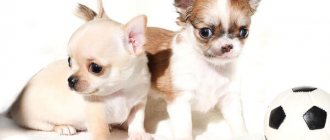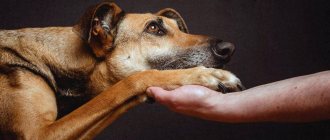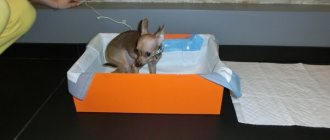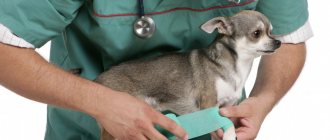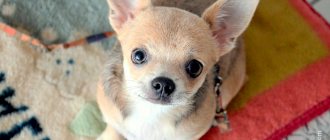The Chihuahua is one of the most famous miniature breeds. For many years, these dogs have been among the ten most popular in the world. This baby is very convenient to keep even in a small apartment. Chihuahuas, even in adulthood, always evoke a feeling of tenderness.
The long-haired Chihuahua is one of the varieties of the breed. This is a small, self-confident dog with a perky disposition. Her miniature size does not prevent her from being decisive and feeling like the center of the Universe. This is an intelligent and loyal animal that can brighten up the life of any person.
Origin and history of the breed
According to archaeological excavations, the history of the Chihuahua goes back several thousand years. The breed's homeland is considered to be the territory of modern Mexico. These dogs accompanied the entire life of the Mayan Indians and were considered sacred. When the owner died, the dog was buried with him. In the absence of food, Chihuahuas were used for culinary purposes. Such traditions continued until America was conquered by Europeans. Together with the Indians, many representatives of miniature dogs fled to the forests.
At the end of the 19th century, representatives of the breed appeared on the markets of Mexico. Local residents began to successfully sell them to Americans. This is how the dogs came to the territory of the United States. They were first exhibited at an exhibition in 1884 in Philadelphia. Chihuahuas came to the territory of the former USSR thanks to Fidel Castro, who gave several dogs to Khrushchev in the late 50s.
Intrabreed species
Chihuahuas come in 2 types of coat:
- Smooth-haired - have a short, thick coat that fits tightly to the body.
- Longhaired – The coat is fine, long and straight. The ears, neck, belly, paws and tail are more abundantly furred. There is also a medium density undercoat.
Mixed coat type is considered a deviation from the norm.
The standard also allows for the division of the breed according to the type of dog design:
- Cobby type - short, stocky, with massive bones. The head is large and “apple” shaped.
- Deer type – looks like small fawns. The head is small, the ears are large. The neck is longer than that of a cobby. The limbs are long and thin.
Although both types are recognized by canine associations, the obby-type (in Mexico - Deer type) is considered more valuable. These varieties of the breed are rarely found in their pure form. Most Chihuahuas may have traits of both types.
Find out about the benefits of 8 in 1 dog vitamin for coat and skin, as well as the rules for using the supplement.
A variety of flavors and an overview of Purina Proplan food lines for small breed dogs can be seen in this article.
Description of the breed
The classic description for a long-haired Chihuahua: height at the withers of the dog is from 15 to 23 cm, weight is 1-3 kg. The head is round and has a specific apple shape. The muzzle is wide at the base, tapering towards the nose, short upturned nose, scissor bite. Round, large eyes are usually dark in color. Ears are erect and wide open, “hanging” in different directions at an angle of 45 degrees. The ears are wide at the base and taper towards the tip.
- The neck is of medium length with an impressive frill of wool around it. A developed chest, which at first glance resembles an oval, is not allowed to be overly rounded in a Chihuahua.
This breed has neat, small, oval-shaped paws. Elastic pads with long, rounded claws, toes well spaced. The tail is of medium length, rather thick at the base and gradually tapering towards the tip. The Chihuahua has a characteristic way of holding its tail - it is either curved high or bent in a semicircle, with the tip of the tail facing the lower back.
- Long-haired Chihuahuas have a soft coat that is fibrous and silky to the touch. Their description differs from the shorthair in having longer hair on the chest, tummy, legs, tail and ears.
Color may vary. The most common colors are white, red, black-brown and fawn. Long-haired Chihuahua puppies are most often born gray or dark red in color; after molting, the color may change to fawn or bright red.
Characteristics and standards
The long-haired Chihuahua has a height at the withers of 15-23 cm, weight 1-3 kg. Although there are smaller specimens. But dog handlers in most cases reject them for further selection; they consider height below 15 cm and weight less than 1 kg to be a sign of dwarfism.
Breed standards:
| Frame | Almost square format, with knots it can be slightly elongated. The chest is deep and wide. The back is flat, straight, smoothly transitioning into the tail. |
| Head | The shape of the skull can be of two types: “deer” and “apple”. Dogs with an apple skull have a large head, a wide forehead, and a small nose. Dogs with a “deer” skull have a smaller head and a more elongated nose. The muzzle is pointed, the transition from the forehead to the nose is clearly defined. |
| Eyes | Cobbies have eyes set at a considerable distance from each other, slightly protruding. In the dirr type they are set closer and less protruding. |
| Ears | Erect, wide at the base, tapering towards the tip. In cobbies they are small, planted far apart. Dirr's ears are large and set high. |
| Tail | Medium length, thick at the base, tapering towards the end. More often, dogs hold their tail high and can bend it over their back, pointing the tip toward the lower back. |
| Paws | The front ones are straight, parallel, the rear ones are more muscular. The joints are convex and well developed. Paws are oval, small. |
| Wool, color | Soft and silky to the touch. Longer on the chest, limbs, ears and tail. Various colors are allowed. The most common: white, black-brown, red, fawn. Puppies are often born with a dark red or gray color, which changes after molting. |
Description of the long-haired species
Let's start getting acquainted with the long-haired pocket dog Chihuahua with a description of the breed and appearance characteristics. So, what does the world's smallest dog look like? The animal, whose weight ranges from 1 to 3 kg, looks cute and attractive.
The height at the withers does not exceed 23 cm. In nature, there are smaller representatives of the Chihuahua dog breed, whose height reaches only 15 cm. The head is apple-shaped, often with an open fontanelle. The muzzle, wide at the base, tapers closer to the nose. The ears are large, set wide, and have a sharp triangular shape. Convex eyes of a dark color attract attention. As experienced dog breeders note, sometimes there is a long-haired Chihuahua with light eye color. However, according to the description of the breed, such dogs are not standard.
The neck is of medium length with a wool edging in the form of a frill collar. The chest of representatives of this breed is well developed. At a quick glance it appears to be oval in shape.
The fore and hind limbs are small in height, but strong and muscular. Paws with soft pads and very sharp claws. The tail is small and carried upward. Often the tip of the ponytail is bent in a semicircle towards the lower back.
The long-haired Chihuahua is a miniature dog with a coat that is soft and silky to the touch. Based on the description of the breed, we can say that the color can be different, individual for each representative of a given species of four-legged. However, the most common long-haired Chihuahua is red, white, fawn or black-brown. At birth, Chihuahua puppies are gray or dark red in color, which changes to fawn or deep red after the first molt.
Similar article: What types of Chihuahua mestizos exist and what is characteristic of them?
Character, intelligence and behavior
The long-haired Chihuahua, despite its miniature size, has a proud and demanding character. This dog's nature has leadership qualities and a desire for dominance. It is difficult for her to get along with other animals in the house, because she is very jealous and loves to have all the attention paid only to her.
Representatives of the breed are very brave and devoted to their beloved owner. They can even get into fights with dogs many times their size. If a Chihuahua doesn't like something, it will snap, bark and even bite.
Note! The breed is distinguished by its intelligence and high level of intelligence. The animal always feels the mood of the owner, but sometimes it is too intrusive.
Advantages and disadvantages
Many people are captivated by the toy appearance and size of long-haired Chihuahuas. But, like any breed, it has its strengths and weaknesses.
Advantages of the breed:
- attachment to the owner;
- cheerful character;
- fast learner;
- low-cost care and maintenance;
- ability to take with you on a trip.
Minuses:
- self-confidence;
- desire to dominate;
- cockiness;
- jealousy;
- requires a lot of attention;
- May be excessive barking.
Care and maintenance
Nutrition
Chihuahua nutrition requires special attention. The diet, regardless of whether you feed your animal dry or natural food, must be balanced. An adult dog should eat no more than twice a day.
You cannot overfeed your pet. Feed from the common table too. Chihuahuas, like other dogs, are prohibited from eating foods such as sausage, sweet and salty foods, pork, and bones.
Lean fish, meat (preferably chicken), fruits and cereals are required.
Chihuahuas are prone to food allergies.
Grooming. Model and hygienic haircuts.
The coat of this breed, and especially if the dog has a fashionable haircut, is a kind of pride of their owners. And at the same time, a subject of regular care. You need to brush your pet daily with a soft brush and bathe it about twice a month using a special shampoo for dogs.
After water treatments, the Chihuahua can be dried with a hairdryer using warm, but not hot air. Be careful not to scare your pet.
Train your Chihuahua to sit still while still a puppy. This will come in handy later during the haircut. Hygienic haircuts should be carried out on the dog at least two to three times a month, especially in the summer. It is advisable to do this before swimming. The haircut allows the long-haired Chihuahua's skin to breathe.
If your dog participates in exhibitions, then, in addition to a hygienic one, you will also need a fashionable haircut that will highlight the advantages of your pet, its physique and overall appearance. A haircut must be of high quality, so it is better to entrust a model's haircut to a professional.
Ears, teeth, claws.
The dog's nails also require attention. They do not wear down naturally, so they require regular trimming. To avoid causing pain to your dog, use a nail clipper specifically designed for clipping.
It is necessary to monitor the cleanliness of your pet’s ears and the condition of its teeth. Chihuahuas are susceptible to plaque and tartar formation. In order not to harm your dog’s health, you can regularly clean your teeth using a special toothpaste for dogs or purchase a special treat in the form of beef vein bones that will clean your pet’s teeth.
Care and conditions of detention
To feel comfortable, long-haired Chihuahuas do not need a lot of space or special care conditions. But in order for the dog to be healthy and develop properly, certain rules of care must be followed.
Tray training
Like other decorative dogs, Chihuahuas need to be taught to go to the toilet in a tray from childhood. In the future, this will eliminate the need to take him outside in bad weather. Select the location where the tray will be installed. Cover it with newspaper or a diaper that smells like puppy urine. As soon as the pet starts spinning, sniffing the floor, place him on this newspaper or diaper. When the puppy gets used to where the toilet is, you can put a tray with low sides. Under no circumstances should you yell at your Chihuahua if it has urinated in the wrong place. You can accustom him to the “fu” command, and when he tries to empty himself into something other than the tray, pronounce it in a clear voice.
Although this dog does not need to go outside to the toilet, it cannot be left indoors all the time. As your pet gets older, it is advisable to take him outside to relieve himself.
Nutrition
First you need to decide on the power system. If you feed a long-haired Chihuahua with ready-made food, you need to choose it from the super premium category.
Natural nutrition should be complete and balanced. Animals must be fed strictly according to the clock. The number of feedings for small puppies is 5-6 times a day. Gradually reduce them to 2. It is better to place the bowl of food on a small hill so that the dog does not strain the shoulder girdle while eating.
The Chihuahua's diet should include lean boiled meat (beef, veal, poultry) every day; once a week you can replace it with offal. The dog should also eat cereals (buckwheat, rice), fermented milk products, stewed or boiled vegetables, and fresh fruits. Once a week you can give a boiled egg.
Prohibited products:
- pork;
- mutton;
- sausages;
- beans;
- sweets.
Place to sleep
The long-haired Chihuahua does not require much open space for comfort. As a rule, he is given a separate corner, which the dog chooses for himself. You can make a dog bed with your own hands or place a small house there. The dog will feel protected in such a home. The house should be located away from radiators, drafts, and doors. Lay soft, warm bedding to keep the animal from freezing. Remove all potentially dangerous objects around that could injure the dog.
Hygiene
The Chihuahua's long coat requires special care; tangles often form on it. Therefore, it needs to be combed with a special brush every 2-3 days, or better yet, daily. During the shedding period, you will have to scratch your dog several times a day. You also need to bathe your dog with a special shampoo once a month. After bathing, dry the coat with a hairdryer.
Periodically remove dirt from your ears and eyes. Check the skin for inflammation and infection with skin and ear mites. Teeth require special attention, with which Chihuahuas often have problems. You need to brush your dog's teeth 2-3 times a week to prevent the formation of tartar and hard plaque. It is also necessary to clean and trim your dog's nails as they grow.
Walks
Chihuahuas need daily walks of 30-40 minutes twice a day. The first walk is best done after breakfast, the second after dinner. In cold weather, walking time is reduced.
It is better not to wear a collar when walking, but to purchase a special harness for your dog. The collar can injure the dog's fragile neck. Walk your Chihuahua in a quiet place, away from large dogs. To avoid injury, it is best to keep him on a leash at all times. The pace of the walk should not be rushed.
Vaccinations and treatment against worms
Chihuahuas need to be vaccinated in a timely manner according to their age against dangerous infectious diseases. First you need to remove worms from the dog using special anthelmintic drugs, and treat against fleas, lice eaters, ticks and other parasites. Before vaccination, a veterinarian must examine the dog. She must be absolutely healthy
Vaccination schedule:
Toys
Chihuahuas need toys, just like children. They help them develop properly and also get rid of boredom during the owner’s absence. When the dog is left alone, you need to leave him a few toys. This will distract her from the desire to spoil things in the house.
To prevent toys from harming the animal, they need to be purchased in specialized stores. They should not have any foreign odors or contain small parts. It is better to prefer toys made of materials such as vinyl, rubber, latex. Products must be comparable in size to the dog's jaw. She can swallow a very small toy, but a large one will not interest her.
Cloth
In cold weather, warm clothes should be provided for the Chihuahua. It is better to wear overalls for a walk. Buy special shoes for dogs for their paws. Clothing must cover the chest, back, and a third of the limbs. In stores you can buy not only clothes for Chihuahuas for the street, but also for the home: pajamas, dresses, booties.
Trimming and haircuts
Long-haired Chihuahuas can be trimmed. If the dog participates in exhibitions, it is better to have it done by a groomer. For hygienic purposes, in order to free it from heavy wool in hot weather, it is cut several times a month. Longer hair is left on the tail, ears, and neck. They cut it in the groin, armpits, under the tail, on the paws.
A model's haircut is done before an exhibition. It can be supplemented with hairpins, bows, and decorations.
A haircut
The long-haired Chihuahua needs periodic grooming. If you plan to participate in exhibitions, then you simply cannot do without the services of a professional groomer. A proper haircut for a Chihuahua is a guarantee of the dog's health and a good entry at the dog show.
- Haircut can be hygienic and fashionable. A hygienic haircut allows the animal’s skin to breathe, which is especially important in hot weather, and protects the dog from overheating. The fur on the back, sides and belly is slightly shortened, leaving a longer coat on the neck, ears, paws and tail. The hair is clipped in hard-to-reach places: armpits, groin, chest, paws, area under the tail.
If a hygienic haircut is done 1-2 times a month, then a model haircut is usually done before the dog is shown. The groomer himself selects the hairstyle based on the dog’s appearance in order to best represent the beauty of the animal. A model haircut can be complemented with any decorative jewelry and hairpins.
Training and education
Long-haired Chihuahuas are easy to train. They need to be educated from early childhood. Accustom the puppy to order, stop barking over trifles. There is no need to take any special training courses for Chihuahuas. But she must learn basic commands. The main thing is that during the educational process the owner does not shout or show aggression. Any cry is stress for the animal. It is imperative to reward your pet for correct behavior.
Find out the instructions for using the antipruritic veterinary drug Apoquel for small breed dogs.
Why does my dog urinate frequently and drink a lot? The probable causes and ways to eliminate them are described in this article.
On the page, read about what and how to sew clothes for a dachshund with your own hands at home.
Features of dog care
The most important aspect of caring for a pet living at home is monitoring its well-being and health. Timely vaccinations and routine visits to the veterinarian will protect your Chihuahua from various ailments. Monitor the condition of the animal's teeth, ears and claws.
The dog needs to be bathed periodically, and one water procedure for a month is enough. For the summer period, the bathing schedule can be revised. After bathing, dry your dog with a hairdryer to prevent the animal from getting cold and catching a cold.
Similar article: Chihuahua breed weight table by month
The Chihuahua is not able to warm itself, so for walks in the autumn-winter period it is necessary to provide your pet with an appropriate wardrobe.
You can buy things for your dog at a pet store or make your own. Daily walks and training are necessary even for such miniature four-legged animals. If you do not raise your pet, then over time it will be difficult to cope with the restless nature of a dog with a choleric temperament.
Who is the dog suitable for?
The long-haired Chihuahua loves to dominate and feel like the main person in the house, and requires increased attention to himself. Therefore, the breed is not suitable for people who are constantly busy at work. It is also not recommended for families with small children. They do not yet know how to properly communicate with a fragile dog and can seriously injure it. Thanks to its miniature size and ease of care, the Chihuahua is suitable for retirees and people with disabilities. The breed is very popular as a decoration among society ladies who take it with them all the time.
